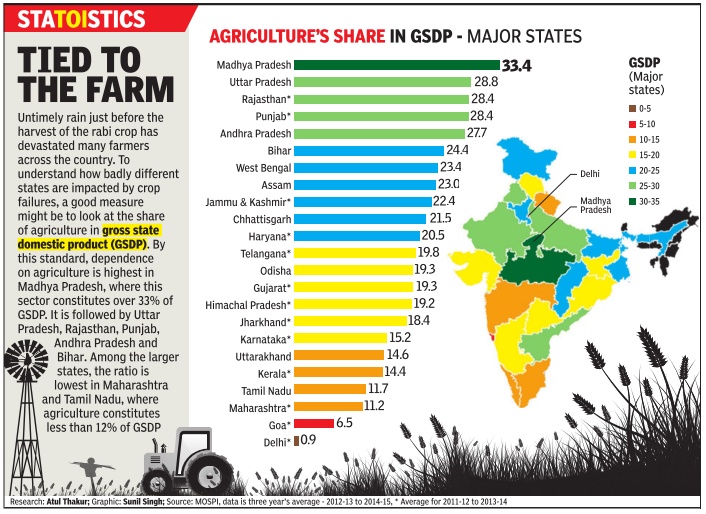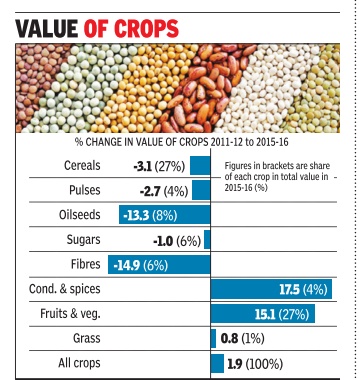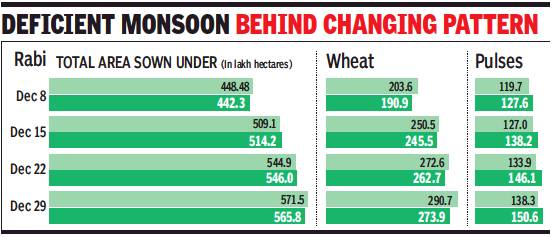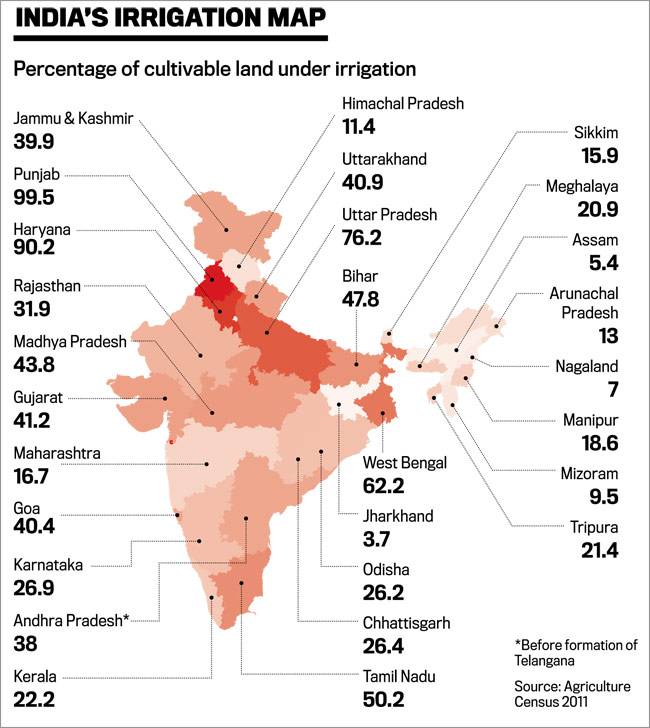Agriculture: India
(→Production: what India grows) |
(→Harvests, yield (foodgrains, pulses)) |
||
| Line 152: | Line 152: | ||
After a bumper season in the previous year, agricultural production is expected to decline in 2018-19. This will be driven by a fall in production of pulses and coarse cereals. Production of foodgrains, coarse cereals and pulses hit a record high in 2017-18. The fall in 2018-19 is due to a disappointing kharif season when production of all major crops is estimated to have declined. The rabi season is also expected to be unsatisfactory. Here's a look. | After a bumper season in the previous year, agricultural production is expected to decline in 2018-19. This will be driven by a fall in production of pulses and coarse cereals. Production of foodgrains, coarse cereals and pulses hit a record high in 2017-18. The fall in 2018-19 is due to a disappointing kharif season when production of all major crops is estimated to have declined. The rabi season is also expected to be unsatisfactory. Here's a look. | ||
| + | |||
| + | |||
| + | ==2020/ rabi== | ||
| + | [[File: Agricultural production in India during the 2020 pandemic, till early June.jpg|Agricultural production in India during the 2020 pandemic, till early June. <br/> From: [https://epaper.timesgroup.com/Olive/ODN/TimesOfIndia/shared/ShowArticle.aspx?doc=TOIDEL%2F2020%2F06%2F13&entity=Ar00202&sk=AA288C49&mode=image June 13, 2020: ''The Times of India'']|frame|500px]] | ||
| + | |||
| + | '''See graphic''': | ||
| + | |||
| + | '' Agricultural production in India during the 2020 pandemic, till early June. '' | ||
| + | |||
| + | [[Category:Development|A | ||
| + | AGRICULTURE: INDIA]] | ||
| + | [[Category:Flora|A | ||
| + | AGRICULTURE: INDIA]] | ||
| + | [[Category:India|A | ||
| + | AGRICULTURE: INDIA]] | ||
| + | [[Category:Name|ALPHABET | ||
| + | AGRICULTURE: INDIA]] | ||
= Horticulture production= | = Horticulture production= | ||
Revision as of 11:11, 6 October 2020
This is a collection of articles archived for the excellence of their content. Readers will be able to edit existing articles and post new articles directly |
Contents |
Cultivable land
India has the largest cropland in the world
November 19, 2017: The Times of India
India, rather than the US or China, has the biggest acreage of agricultural land in the world. Global cropland totals 1.87 billion hectares (4.62 billion acres), more than 15% higher than earlier estimates, according to a map released by the US Geological Survey. India has the largest cropland of any country at 179.8 million hectares, compared with 167.8 million in the US and 165.2 million in China.
Cultivable land continues to shrink
Cultivable land continues to shrink
Vishwa Mohan TNN
New Delhi: Cultivable land in India continues to shrink. It may not pose an immediate problem for the nation’s food security but its long-term effect could be disastrous with the country needing more and more foodgrains to support its growing population.
Latest data from the agriculture ministry shows that as many as 20 states reported decrease in cultivable land to the extent of 790,000 hectares in four years from 2007-08 to 2010-11. The decrease is mainly attributed to diversion of cultivable land for non-agricultural purposes, including construction, industries and other development activities.
Since such diversion is inevitable, the government had in its National Rehabilitation and Resettlement Policy (NRRP), 2007 recommended several measures to keep a tab on ever-decreasing cultivable land in the country.
But the data, shared by the agriculture ministry in response to a question in the Lok Sabha on Tuesday, shows that only five states have taken some steps to increase the areas under cultivation and three others (Assam, Goa and Sikkim) have adhered to the policy of not tinkering with land which can be used for farming.
Gujarat is the only big state which increased the area of cultivable land during four years from 2007-08 to 2010-11. Manipur, Mizoram, Jammu & Kashmir and Arunachal Pradesh are the other states which reported increase.
Haryana showed the sharpest decline in area under cultivation. The small state reported decrease of 65,000 hectares of agricultural land between 2007-08 and 2010-11.
Since land falls under the purview of states as per the seventh Schedule of the Constitution, it is for states to bring in suitable policy to prevent diversion of agricultural land for non-agricultural purposes. The Centre had under its 2007 policy advised states to allow development projects to come up on wastelands.
Under NRRP, states were advised that acquisition of agricultural land for nonagricultural use should be kept to the minimum, multicropped land should be avoided to the extent possible for such purposes and acquisition of irrigated land, if unavoidable, may be kept to the minimum.
But it seems most states have not followed the norms, leading to overall decrease of nearly 406,000 hectares of cultivable land in the country during the four-year period.
Under Irrigation
Ajit Kumar Jha , Irrigation map “India Today” 12/6/2017
See graphic
Growth
Growth rate of agriculture/ 2015-16
Ajit Kumar Jha , Growth rate of agriculture 2015-16 No country for farmers “India Today” 12/6/2017
See graphic 'India Today , June 12,2017' (Growth rate of agriculture 2015-16

See graphic 'Share of agriculture in GSDP, state-wise'
Harvests, yield (foodgrains, pulses)
Cereal yield
2011-16: Profitability in cultivation, a decline
Subodh Varma, For farmers, grass is greener than wheat & rice , June 25, 2017: The Times of India

Growing grass and selling it in the market may be more profitable than cultivating crops such as wheat, rice, pulses and oilseeds.This bizarre conclusion, a reflection of the desperate conditions of Indian farmers, can be reached if one looks at how the value of various crops has changed.
Between 2011-12 and 201516, the total value of cereals and pulses produced in the country went down by about 3%, oilseeds by over 13% and sugars by 1%. But value of grass, which is mainly used as cheap forage for milch animals, increased by about 1%. Output values zoomed up for two types of food items -fruits and vegetables by over 15% and condiments and spices by nearly 18%. This information is derived from the latest National Accounts Statistics 2017 released by the Central Statistics Office. It is this declining output value, which is at the root of farmers' sorrow and an ger, finding expression in a range of ways from suicides to agitations demanding loan waivers or even job reservations for specific communities. Output values are declining because the cost of what the farmers put in -seeds, fertilisers, water etc. is rising faster than the prices they get by selling their produce.
Nearly a third of the total value of agricultural production in India was contributed by cereals and the same by fruits and vegetables, up from about 24% five years ago. Many of the estimates of output value, which is obtained by multiplying total production of a crop by prevailing prices for that crop, are broad guesses, says Vikas Rawal, associate professor of economics at JNU. He especially flagged fruits and vegetables estimates at being sketchy and growth rate seeming to be higher because of starting off from a lower base.
“But, even then, the data does show that most farmers, involved in food grain production, are not getting good returns for their investment and labour,“ he told TOI. Fruits and vegetables have emerged as a much more attractive investment for farmers because of a mix of several reasons. With nearly half of the cultivated land in India under small and marginal holdings of less than two hectares, it has become increasingly difficult for farmers to manage the longer duration and more demanding crops like cereals, pulses and oilseeds.Vegetables offer the big advantage of needing much less fertilizers or pesticides, and they can grow up and be ready for cash sale within 2-4 months. With prices of pulses sky-rocketing, demand for vegetables too has shot up. Better transport facilities and road connectivity eases marketing. But everybody can't start growing only vegetables and fruits. Besides not paying enough, their marketing is subject to many risks including sharp price fluctuations and perishability .Food grains can provide much more security and larger incomes provided prices are good. And, the govt. too provides some support through various subsidies and procurement. Ultimately, the whole country survives on the food grains produced by farmers.
2015: Poor rainfall but kharif sown area rises 12 lakh ha

The Times of India, Sep 25 2015
Despite rainfall deficit, kharif sown area rises by 12 lakh ha Rise in areas under pulses and oilseeds
In what could be an indication of higher foodgrain production, the country this year recorded an increase of nearly 12 lakh hectares in total kharif sown area as on Thursday compared to the corresponding period last year, despite almost similar amount of rainfall deficit during June-September monsoon season. The agriculture ministry figures on kharif sown area show that the total area under summer crops reached 1026.23 lakh hectares as com pared to 1014.24 lakh hectares ast year at this time.
Except cotton and jute, sown area under other major crops, including pulses and oilseeds, increased this year as compared to 2014 reflect ng the positive impact of con ingency measures taken by he government, based on ad vance input of deficit rainfall rom the IMD. Such measures helped farmers in different ways to ensure sowing operation after late revival of monsoon in certain regions.
In fact, sown areas under pulses, oilseeds, sugarcane and cotton are more than normal' sown area of these crops. `Normal' sown area is calculated as an average of sown area of a particular crop in last five years.Though the area under cotton (115.20 lakh hectares) is less than last year (125.75 lakh hectares), it is still higher than its normal sown area (115.02 lakh hectares).
The country has so far reported 12% rainfall deficit, however, this figure will slightly change once IMD comes out with its final report covering June-September period.
Though the initial report estimates slightly less foodgrain production this year as compared to last year, the in crease in sown area shows sign of improvement with some regions witnessing late start of sowing operation.
According to data, the sown area under rice was 374 lakh hectares as compared to 373 lakh hectares last year.While sown area under pulses stand at 113.45 lakh hectares as compared to 101.83 lakh hectares last year, the area under oilseeds reached 183.68 lakh hectares as compared to 177.49 lakh hectares in 2014.
Though the government's first `advance estimate' put the total kharif foodgrain production for the year 2015-16 at 124.05 million tonnes (MT), which is 2.26 MT less than the `actual' kharif output of 201415, it is expected the output would eventually increase backed by higher sown areas under different crops.
2016-17: Good monsoon
Backed by welldistributed monsoon rains this year, India is expected to register a record foodgrain production during the 201617 crop year (July-June). The government has already set a target of 270.10 million tonnes of yield for the year -surpassing its previous record of 265.04 million tonnes in 2013-14.
Though the current year has reported 5% of deficit rainfall so far, adequate rains in July and August, especially in water stressed areas, where it was needed during peak sowing season, has sent positive signals.
Rainfall this year got the water level in major reservoirs up to satisfactory levels as compared to two consecutive drought years of 2015 and 2014 when the country had reported 14% and 12% of deficit rains respectively. This along with good soil moisture condition has signalled the possibility of better rabi season in terms of acreage, making the prospect of achieving the target of record foodgrain production brighter.
“Overall, monsoon has been favourable for farmers this year. We have received good rains and distribution was also good. I am sure, we will have record production this year,“ Union agriculture minister Radha Mohan Singh said while addressing a conference on rabi crops.
The government has a target of 20.75 million tonnes (MT) for pulse production during 2016-17 which includes 13.50MT of pulses output from the rabi season.
Urging states to promote pulses even in the rabi season beginning October, Singh said, “States should prepare work plans for more coverage of rabi pulses and oilseeds in rain-fed areas.“
2017-18: Higher sown area under Rabi

From: Vishwa Mohan, Overall rabi sown area dips, but pulses’ on rise, December 30, 2017: The Times of India
Hike In MSP Pushes Farmers To Diversify Crop Pattern
After recording marginally higher sown area under Rabi crops for the past two weeks this month as compared to the corresponding period last year, the overall sown area dipped again on Friday.
But farmers’ choice to bring more area under pulses kept hopes alive for a good farm production during 2017-18 crop year (July-June).
Though the overall dip is attributed to sharp decline in area under wheat, the 9% rise in sown area under pulses so far (from 138.34 lakh hectares in 2016-17 to 150.63 lakh hectares this year) has kept the gap less.
The sown area data, released by the agriculture ministry, show that the total area under rabi crops as on Friday stand at 565.79 lakh hectares as compared to 571.47 lakh hectares at this time last year.
“Deficient monsoon rainfall in wheat growing Uttar Pradesh and Madhya Pradesh resulted in less soil moisture and therefore the farmers in these two states and elsewhere opted not to go for bigger areas under wheat. Instead, they opted for pulses which use less water from deep soil,” said an official.
He said the larger area under pulses has indicated that the farmers have also diversified their cropping pattern a bit, keeping in view the increase in minimum support prices (MSP) for the 2017-18 crop year.
The government had in October increased MSP of six Rabi crops. Though the MSP of wheat was also increased (by 6.8%), the hike was higher for pulses. The MSP of gram was increased from Rs 4,000 per quintal last year to Rs 4,400 per quintal in 2017-18— a hike 10% per quintal.
Officials, tracking the sowing operations, believe that the marginal dip in overall sown area under Rabi crops is not a sign of worry as farmers still have three-four weeks of sowing operation left for different crops.
2019
Fall in production of food grains, coarse cereals

Cotton production, 2017-18
From: Fall in production of foodgrains, coarse cereals to drag down agriculture harvest in FY19, February 4, 2019: The Times of India
After a bumper season in the previous year, agricultural production is expected to decline in 2018-19. This will be driven by a fall in production of pulses and coarse cereals. Production of foodgrains, coarse cereals and pulses hit a record high in 2017-18. The fall in 2018-19 is due to a disappointing kharif season when production of all major crops is estimated to have declined. The rabi season is also expected to be unsatisfactory. Here's a look.
2020/ rabi

From: June 13, 2020: The Times of India
See graphic:
Agricultural production in India during the 2020 pandemic, till early June.
Horticulture production
See: Horticulture: India
Organic farming in India
2010-14, lack of financial support to organic farms
The government under a national programme promotes organic farming, ongoing projects and financial outlays that had gone into the process in the past four years does not appear to be enough to match the rising demand of chemical fertilizer-free and pesticide-free food products.
Organic farming involves an ecological production management system that promotes and enhances biodiversity, biological cycles and soil biological activity in a sustainable manner. Farmers do not use chemical fertilizer and pesticides in such farm practices.
Although the government has devised a number of plans to promote organic farming in the country, the extent of financial support under a national programme is quite less. It was just Rs 129.91 crore in 2010-11 under the Rashtriya Krishi Vikas Yojna (RKVY) - a key national programme - to promote organic farming. Though the amount was increased for the purpose to Rs 311.31 crore in 2011-12, it fell down to Rs 143.81 crore in 2013-14. The amount is quite less if one compares it with the total amount (Rs 9968.72 crore in 2013-14) allocated by the Centre to the RKVY for overall promotion of agriculture.
Financial assistance is provided through state governments for organic village adoption for manure management and biological nitrogen harvesting, promotion of organic input production on farmer's field and promotion of certification for area under organic farming for export purposes.
Aquaponic farm/ Gurugram, 2017
GURUGRAM: There is a huge demand for organic farming in the country right now specially after reports of high level of chemicals and toxic in the vegetables being sold in the markets. Many urban dwellers have even taken up kitchen gardening which however, is often restricted due to want of space.
Gurugram based Sushant Madaan is one such organic farming enthusiast who has set up a first of its kind aquaponic farm in Northern India. Aquaponics, a technique that marries horticulture and aquaculture helps the farmer raise fishes while he also grows plants.
"In aquaponics we grow fish and plants together in a tank. The tank has fishes in it and on the sides of the tank there are beds for plants. The water from the fish tank which is rich in nutrients due to the fish waste goes into the plants," said Madaan.
The beds for supporting the plants can be made using material such as thermocol sheets or gravel. Madaan setup the farm in June this year and will be growing only leafy vegetables for this season.
He has done a Master of Science in Sustainable energy systems from Netherlands and Sweden and has been exploring different organic farming techniques for a while. Madaan says that not only aquaponics is a great way to get organic produce but it is also gaining popularity among urban farmers who are trying it as a hobby. This technique of agriculture is an organic farming technique as there is no use of any fertilisers plus it.
District horticulture officer who has been tracking the project said, "It is the first of its kind aquaponic project in Northern India and is a great technique especially with the ever increasing demand of organic fruits and vegetables in the urban areas," said Deen Mohammad Khan. Khan added that the technique which is currently new in India is very widely used in countries like Japan and China. According to Madaan, the cost of setting up an aquaponics farm ranges between Rs. 5 lakhs to Rs. 15 lakhs. While the setup cost of aquaponic farm might be higher than conventional farms, but the operational cost is much less as there is no need for fertilizers and the water requirement is 90% less than that required in conventional farming. Also the yield from aquaponics is two times higher than that of conventional farming. However, one restriction being that fruits and vegetables which grow underground cannot be grown using aquaponics.
Production: what India grows
2012-18

From: September 4, 2018: The Times of India
See graphic:
Production of foodgrains, vegetables and fruits in India, 2012-18
2007-18: Crop output

From: January 26, 2019: The Times of India
See graphic:
2007-18: Crop output in India
Quinoa and other S. American seeds
The Times of India, Apr 11 2016
S. America seeds give rich dividends in UP
Arindam Ghosh After giving half a century to farming of pulses and wheat, with depleting yield due to drought or erratic rains, 62-year-old Jagmohan Rajpoot of Rigwara Khurd village in Hamirpur can look forward to a new lease of life -in cultivation of quinoa, a cash crop native to South America that requires minimal irrigation and fetches high price in foreign market. Around 286 farmers have chosen to grow quinoa on 2,100 acres and are earning a handsome profit. They are also growing moringa trees (drumsticks or `sehjan ki phali` as locals call it). Both plants grow in adverse weather conditions and are adaptable to all kinds of soil. Krishan Gupta, MD of an organic products firm said, “We are providing seeds and technical aid and buying the produce at best price besides offering them 5% profit share.“
Krishan's French buyer Pierre Alex Hubber has been dealing in these agriculture products for the past 15 years. During his recent visit to Hamirpur, he said, “ The produce here is pure as crops are being grown in virgin land free from pesticides.“
See also
Agriculture: India
Agriculture: Indian government data
Farmers, cultivators and their issues including Farm loans




